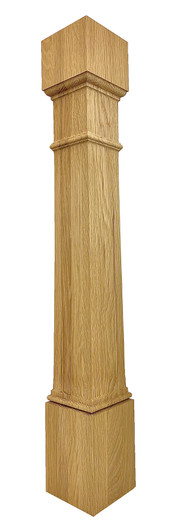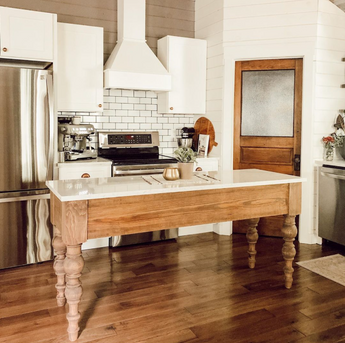Discovering the Essential Features of a Cooking Area Island Leg for Your Culinary Space
The kitchen area island acts as a central center in any kind of cooking space, and the option of leg layout is crucial in boosting both its functionality and visual allure. Understanding the vital features of cooking area island legs-- consisting of product options, design styles, and stability aspects-- can significantly influence the total experience within the cooking area. As we explore these elements, we will certainly reveal just how thoughtful customization and devices can raise your kitchen area island from a mere energy to a striking focal point. What details considerations should be prioritized to accomplish this balance?
Relevance of Kitchen Island Legs
Cooking area island legs play a crucial role in both the performance and visual appeals of a kitchen area area. They not just sustain the weight of the island yet also boost the general layout, adding to the cooking area's visual allure. The selection of legs can dictate the style of the kitchen, be it modern-day, typical, or rustic.
Functionally, robust and properly created legs make sure stability, permitting for the secure use the island for numerous tasks such as cooking, eating, or enjoyable. Strong legs protect against shifting and wobbling, offering a reputable surface for daily tasks.
Additionally, the height and placement of the legs can affect the comfort degree for those seated at the island. A well-considered elevation can suit bar feceses or chairs, promoting an inviting setting for events.
Along with these functional considerations, cooking area island legs can work as a centerpiece in the space (kitchen island leg). Decorative or uniquely developed legs can raise the layout aesthetic, making the island a focal point. Hence, picking the appropriate kitchen island legs is necessary for balancing form and feature in any kind of cooking room
Product Options for Legs
Selecting the proper material for cooking area island legs significantly influences both longevity and style. Typical material options consist of stone, metal, and wood, each offering unique advantages.
Wood is a prominent selection as a result of its heat and versatility. It can be quickly personalized to match various decor styles, from rustic to contemporary. Hardwoods like oak and maple give superb strength and long life, while softer timbers can be much more vulnerable to tear and use.
Metal legs are favored for their smooth, modern-day visual. kitchen island leg. Stainless-steel and light weight aluminum are not only durable yet also immune to rust and rust, making them ideal for cooking area settings. They can produce an industrial appearance and are typically available in numerous surfaces to match various other kitchen area aspects
Stone legs, such as granite or marble, add a component of deluxe and stability. While heavier than various other materials, they provide outstanding sturdiness and can stand up to substantial weight. Nevertheless, they might call for added support to make sure correct balance.
Ultimately, the choice of material ought straight from the source to line up with both useful needs and the general style vision of the kitchen area, making sure that the island legs enhance both utility and aesthetics.
Layout Styles to Think About
What style styles should be considered when selecting legs for a kitchen area island? The selection of leg design substantially affects the general visual of your culinary space. For a modern kitchen, smooth and minimalistic leg designs, such as stainless-steel or geometric forms, can boost the modern-day appeal, providing a clean and uncluttered appearance.
On the other hand, conventional kitchen areas gain from classic designs such as turned or carved wood legs, which include warmth and personality. These choices commonly include complex details that complement vintage home furnishings. For a rustic atmosphere, take into consideration legs made from recovered timber or wrought iron, which bring an organic, natural quality to the room.
If you lean in the direction of a commercial style, robust metal legs with a distressed coating may be excellent, giving an edgy yet innovative touch. Additionally, farmhouse style cooking areas can incorporate chunky legs that stimulate a sense of toughness and homeliness.

Height and Security Factors
The elevation and stability of a kitchen island are important components that directly affect its performance and customer experience. An optimal kitchen island leg should provide adequate height to accommodate a selection of tasks, from food preparation to informal dining.
Stability is equally crucial, particularly as cooking area islands usually act as this page focal points in culinary atmospheres. A steady leg style decreases tottering and moving, which can bring about crashes or pain during use. Materials such as solid wood, steel, or a combination thereof are frequently used to accomplish the essential durability. Additionally, the leg's attachment to the island's base must be secure, making sure longevity and resilience against the visit our website wear and tear of day-to-day use.
Modification and Devices
Personalization options and accessories for kitchen island legs can dramatically enhance both the visual charm and functionality of the room. Homeowners can pick from a selection of products, including metal, stone, and wood, enabling seamless integration with existing cooking area decoration. The option of surface-- be it an all-natural stain, paint, or powder covering-- more personalizes the appearance, ensuring that the island matches the overall design style.
Along with product and finish, homeowners may likewise discover the incorporation of accessories such as ornamental brackets, flexible feet, or integrated shelving. Braces can provide extra support while contributing to a rustic or modern-day aesthetic. Adjustable feet are particularly advantageous for uneven flooring, ensuring the island continues to be stable and level, which is vital for both safety and use.

Conclusion
In conclusion, kitchen area island legs serve a vital role in supplying stability and enhancing the overall visual of the cooking room. Customization options and devices can boost the kitchen island, making it a distinctive focal point within the home.
The kitchen area island offers as a main hub in any type of culinary space, and the selection of leg style is crucial in enhancing both its performance and visual charm. Recognizing the important attributes of kitchen island legs-- consisting of product alternatives, design styles, and security aspects-- can considerably affect the general experience within the kitchen.Cooking area island legs play a crucial duty in both the performance and visual appeals of a kitchen area.What style styles should be thought about when selecting legs for a kitchen area island?In verdict, kitchen area island legs serve a vital role in giving security and enhancing the total aesthetic of the culinary room.